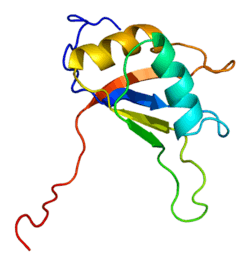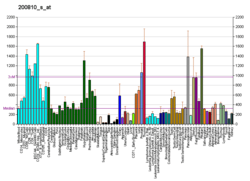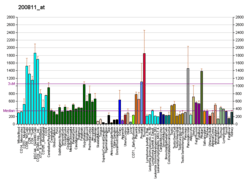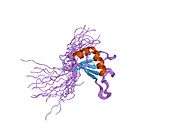CIRBP
Cold-inducible RNA-binding protein is a protein that in humans is encoded by the CIRBP gene.[5][6][7] The cold inducible RNA-binding protein CIRBP plays a critical role in controlling the cellular response upon confronting a variety of cellular stresses, including short wavelength ultraviolet light, hypoxia, and hypothermia.
References
- 1 2 3 GRCh38: Ensembl release 89: ENSG00000099622 - Ensembl, May 2017
- 1 2 3 GRCm38: Ensembl release 89: ENSMUSG00000045193 - Ensembl, May 2017
- ↑ "Human PubMed Reference:".
- ↑ "Mouse PubMed Reference:".
- ↑ Nishiyama H, Higashitsuji H, Yokoi H, Itoh K, Danno S, Matsuda T, Fujita J (Feb 1998). "Cloning and characterization of human CIRP (cold-inducible RNA-binding protein) cDNA and chromosomal assignment of the gene". Gene. 204 (1–2): 115–20. doi:10.1016/S0378-1119(97)00530-1. PMID 9434172.
- ↑ Nishiyama H, Itoh K, Kaneko Y, Kishishita M, Yoshida O, Fujita J (Jun 1997). "A Glycine-rich RNA-binding Protein Mediating Cold-inducible Suppression of Mammalian Cell Growth". J Cell Biol. 137 (4): 899–908. doi:10.1083/jcb.137.4.899. PMC 2139845. PMID 9151692.
- ↑ "Entrez Gene: CIRBP cold inducible RNA binding protein".
External links
- Human CIRBP genome location and CIRBP gene details page in the UCSC Genome Browser.
Further reading
- Sheikh MS, Carrier F, Papathanasiou MA, et al. (1997). "Identification of several human homologs of hamster DNA damage-inducible transcripts. Cloning and characterization of a novel UV-inducible cDNA that codes for a putative RNA-binding protein". J. Biol. Chem. 272 (42): 26720–6. doi:10.1074/jbc.272.42.26720. PMID 9334257.
- Nishiyama H, Danno S, Kaneko Y, et al. (1998). "Decreased expression of cold-inducible RNA-binding protein (CIRP) in male germ cells at elevated temperature". Am. J. Pathol. 152 (1): 289–96. PMC 1858111. PMID 9422546.
- Lee J, Bedford MT (2002). "PABP1 identified as an arginine methyltransferase substrate using high-density protein arrays". EMBO Rep. 3 (3): 268–73. doi:10.1093/embo-reports/kvf052. PMC 1084016. PMID 11850402.
- Strausberg RL, Feingold EA, Grouse LH, et al. (2003). "Generation and initial analysis of more than 15,000 full-length human and mouse cDNA sequences". Proc. Natl. Acad. Sci. U.S.A. 99 (26): 16899–903. doi:10.1073/pnas.242603899. PMC 139241. PMID 12477932.
- Hamid AA, Mandai M, Fujita J, et al. (2004). "Expression of cold-inducible RNA-binding protein in the normal endometrium, endometrial hyperplasia, and endometrial carcinoma". Int. J. Gynecol. Pathol. 22 (3): 240–7. doi:10.1097/01.PGP.0000070851.25718.EC. PMID 12819390.
- Ota T, Suzuki Y, Nishikawa T, et al. (2004). "Complete sequencing and characterization of 21,243 full-length human cDNAs". Nat. Genet. 36 (1): 40–5. doi:10.1038/ng1285. PMID 14702039.
- Grimwood J, Gordon LA, Olsen A, et al. (2004). "The DNA sequence and biology of human chromosome 19". Nature. 428 (6982): 529–35. doi:10.1038/nature02399. PMID 15057824.
- Wellmann S, Bührer C, Moderegger E, et al. (2004). "Oxygen-regulated expression of the RNA-binding proteins RBM3 and CIRP by a HIF-1-independent mechanism". J. Cell Sci. 117 (Pt 9): 1785–94. doi:10.1242/jcs.01026. PMID 15075239.
- Gerhard DS, Wagner L, Feingold EA, et al. (2004). "The Status, Quality, and Expansion of the NIH Full-Length cDNA Project: The Mammalian Gene Collection (MGC)". Genome Res. 14 (10B): 2121–7. doi:10.1101/gr.2596504. PMC 528928. PMID 15489334.
- Rual JF, Venkatesan K, Hao T, et al. (2005). "Towards a proteome-scale map of the human protein-protein interaction network". Nature. 437 (7062): 1173–8. doi:10.1038/nature04209. PMID 16189514.
- Lim J, Hao T, Shaw C, et al. (2006). "A protein-protein interaction network for human inherited ataxias and disorders of Purkinje cell degeneration". Cell. 125 (4): 801–14. doi:10.1016/j.cell.2006.03.032. PMID 16713569.
- Ewing RM, Chu P, Elisma F, et al. (2007). "Large-scale mapping of human protein–protein interactions by mass spectrometry". Mol. Syst. Biol. 3 (1): 89. doi:10.1038/msb4100134. PMC 1847948. PMID 17353931.
This article is issued from
Wikipedia.
The text is licensed under Creative Commons - Attribution - Sharealike.
Additional terms may apply for the media files.







